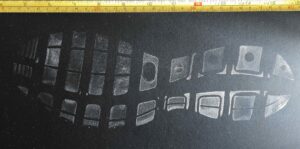
For years, criminal investigators and forensic scientists have used fingerprints to determine identity. More recently, footprints have been discovered to be an equally reliable identifier.
Every person’s foot has a unique set of ridges that make up a print unmatched by any other human being. As with fingerprints, the footprint’s pattern is a unique characteristic that can pinpoint any one particular person. An actual footprint can be checked and matched to an existing print on record, such as one from a birth certificate.
While footprints can be used as a method of forensic science, more often the prints at a crime scene do not come from a bare foot. To compensate, scientists have created methods of identifying shoe prints. The indentations on the ground made by any shoe can be studied, recorded, and matched to prints found at other locations. Therefore, if one set of shoeprints is found at the scene of a crime, it can be compared to another set of prints found at a separate crime scene. A matching print tells investigators that the same person was involved in both crimes.
To preserve the prints, detectives take detailed photographs that can be scanned into computers for analysis. In many cases, technicians will make a casting of the print so that a duplicate may be produced. The casting process involves pouring a dense liquid into the actual shoe imprint and allowing it to set. After the liquid solidifies, the casting can be picked up as one piece so that an exact replica will be available for future reference.
Forensic scientists can also make other determinations about a suspect based on their shoe print. The size of the shoe allows them to estimate the height of the person in question. By comparing how deep the print is in connection with how solid the soil was and whether or not the ground was damp at the time, investigators can gain a better idea of the weight of the person. All of these methods can help determine the criminal’s identity.
